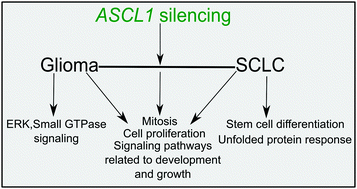System analysis identifies distinct and common functional networks governed by transcription factor ASCL1, in glioma and small cell lung cancer†
Abstract
ASCL1 is a basic Helix–Loop–Helix transcription factor (TF), which is involved in various cellular processes like neuronal development and signaling pathways. Transcriptome profiling has shown that ASCL1 overexpression plays an important role in the development of glioma and Small Cell Lung Carcinoma (SCLC), but distinct and common molecular mechanisms regulated by ASCL1 in these cancers are unknown. In order to understand how it drives the cellular functional network in these two tumors, we generated a gene expression profile in a glioma cell line (U87MG) to identify ASCL1 gene targets by an si RNA silencing approach and then compared this with a publicly available dataset of similarly silenced SCLC (NCI-H1618 cells). We constructed TF–TF and gene–gene interactions, as well as protein interaction networks of ASCL1 regulated genes in glioma and SCLC cells. Detailed network analysis uncovered various biological processes governed by ASCL1 target genes in these two tumor cell lines. We find that novel ASCL1 functions related to mitosis and signaling pathways influencing development and tumor growth are affected in both glioma and SCLC cells. In addition, we also observed ASCL1 governed functional networks that are distinct to glioma and SCLC.



 Please wait while we load your content...
Please wait while we load your content...